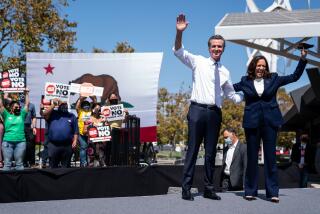Editorial: Should California allow cyclists to roll through stop signs? Let’s give it a try
- Share via
Should a bicyclist be allowed to roll though a stop sign when there’s no traffic around? Idaho lawmakers thought so when they loosened rules for bike riders more than 30 years ago, allowing them to treat a stop sign like a yield sign.
Intuitively, it seems unsafe. Don’t we put stop signs in places where traffic needs to, you know, stop? Yet changing the law didn’t result in carnage on Idaho’s streets. Not only didn’t cycling become more dangerous in that state, it apparently got safer. One study found that overall cycling injuries decreased in the year after the law changed and there was no significant change in fatalities. Was that because of the new law? Maybe.
According to Boise bike and pedestrian advocates, the new approach was a success, though the evidence is mostly anecdotal. Motorists didn’t freak out and pedestrians weren’t mowed down by bike riders emboldened to break other rules of the road. And there was no uptick in collisions with bicyclists. That’s great for Boise, but would it work in Burbank? That’s a question California lawmakers will grapple with Monday when they consider passing a version of the “Idaho Stop” law that would allow bicycles statewide to treat stop signs as yield signs. Bikes would still have a legal duty to stop for pedestrians and cars that have the right of way.
Would loosening the rules about stop signs make the confusion worse? Let’s find out.
The Idaho experience suggests there’s a benefit to adopting a similar practice in California as the state tries to encourage cleaner forms of transportation. But a suggestion is not enough to support such a radical and conceivably dangerous change. Few things spark such antipathy toward cyclists as the sight of riders blowing through intersections. What we need is more data.
This may sound like a cop-out in a pretty polarizing debate, but it’s not. Rather than rejecting Idaho stops outright (as lawmakers in Colorado did earlier this year as part of a bill that would have allowed cyclists to run some red lights as well), lawmakers should try it out. France did pilot programs in some of its cities; Paris eventually adopted the practice. A pilot program in a city or cities in California would take the hyperbole out of the debate by providing hard facts with which to test the claims from both sides.
Bike advocates say changing the law would codify what is already a regular and safe practice by most bike riders to slow down and look around before rolling through intersections, and would stop inconsistent enforcement of the law. Opponents, including the California Police Chiefs Assn. and the Automobile Club of Southern California, respond that bicyclists’ habit of breaking the law isn’t a good reason to change it. Besides, they say, California is not Idaho, and rolling through a stop sign would be dangerous here. Only hard facts are going to bring these two sides together.
Motorists should support a test run as well. It may seem counterintuitive, but letting cyclists safely roll through intersections may actually improve the traffic flow on residential streets. Consider this scenario: A bicyclist reaches a four-way intersection before a car approaching from her left, and she has the right of way. The car driver must wait until the law-abiding bike rider comes to a full stop, then slowly gets going again. If the bicyclist had been allowed to slow but not stop, it would have cut the car’s waiting time — not by a lot, but enough to make a difference on heavily trafficked residential streets in cities like Los Angeles.
It could make a journey safer for cyclists as well. Streets with stop signs generally have lighter car traffic than those with signals. But having to stop at every sign when there are no cars around is not just inconvenient, it’s exhausting. It takes considerably more energy to pedal from a full stop than to just a slow down and then continue. Some bicycle advocates say that law-abiding bike riders may naturally choose the faster yet more perilous busy roadways over side streets.
Will pedestrians be creamed by bike riders flying through intersections? Probably not. If California bicyclists are already rolling through stop signs routinely (and studies indicate they are) then pedestrians here aren’t paying a big price for it now. According to the California Highway Patrol, in 2016 there were 119 injury collisions between bicycles and pedestrians in the entire state, down from 144 the year before and 162 in 2014. And since 2014, only two people have been killed in bike-pedestrian collisions.
Both supporters and opponents agree that there’s a lot of confusion among motorists about the rules regarding bicycles. Many don’t realize that bicycles have as much right to the road as cars and that state law allows them to take up an entire lane of traffic when there’s not enough room on the right side of the road. Would loosening the rules about stop signs make the confusion worse? Would it incentivize cyclists to break other laws and make it harder for police to issue tickets for running stop signs? Or would it improve traffic flow and encourage more people to ditch their cars for bikes?
Let’s find out.
Follow the Opinion section on Twitter @latimesopinion and Facebook
MORE FROM OPINION
City leaders should be fighting for more access to Griffith Park and Hollywood sign, not less
Deep down, Las Vegas isn’t ‘alien territory.’ It just plays that way in our imaginations
Using abortion as an excuse to deny Californians subsidized healthcare is unnecessary and cruel
More to Read
A cure for the common opinion
Get thought-provoking perspectives with our weekly newsletter.
You may occasionally receive promotional content from the Los Angeles Times.









